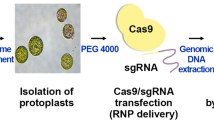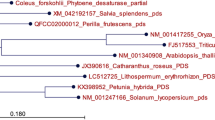Abstract
Hordothionins (HTHs) are small anti-bacterial proteins present in barley endosperm which are processed from larger precursor proteins, consisting of an amino-terminal signal peptide (SP), the mature highly basic HTH and a carboxy-terminal acidic peptide (AP). Different HTH precursor proteins were expressed in tobacco to study the effects of the pre-sequences (SP) and pro-sequences (AP) on expression, processing, sorting and biological activity and hence the feasibility of engineering bacterial disease resistance into crops which lack these proteins. Maximum HTH expression levels of approximately 0.7% (11 μmol/kg) of total soluble protein in young tobacco leaves were obtained using a semi-synthetic gene construct encoding a complete chimaeric HTH precursor protein. Tenfold lower HTH expression levels (maximum 1.3 μmol/kg) were obtained using synthetic gene constructs without the AP-coding sequence and no expression was found in plants containing synthetic HTH gene constructs without SP-and AP-coding sequences. In both cases where expression was found, the precursors were apparently correctly processed, although the HTH produced in plants containing a construct without AP sequence appeared to be slightly modified. No effect on plant phenotype was observed. Localization studies indicated that the HTH was in identical fractions of plants expressing the two different precursors, albeit at a different ratio, and was not secreted into the intercellular spaces of leaves or culture medium by protoplasts. Our results indicated that the AP is not involved in sorting and suggested that it might facilitate transport through membranes. The in vitro toxicity of HTH isolated from transgenic tobacco plants expressing the two different precursor proteins for the bacterial plant pathogen Clavibacter michiganensis subsp. michiganensis appeared similar to that of the HTH purified from barley endosperm.
Similar content being viewed by others
References
Bohlmann H, Apel K: Isolation and characterization of cDNAs coding for leaf-specific thionins closely related to the endosperm-specific hordothionin of barley (Hordeum vulgare L.). Mol Gen Genet 207: 446–454 (1987).
Bohlmann H, Clausen S, Behnke S, Giese H, Hiller C, Reimann-Philipp U, Schrader G, Barkholt V, Apel K: Leaf-specific thionins of barley—a novel class of cell wall proteins toxic to plant-pathogenic fungi and possibly involved in the defense mechanism of plants. EMBO J 7: 1559–1565 (1988).
Bradford MM: A rapid and sensitive method for the quantitation of microgram quantities of protein utilizing the principle of protein-dye binding. Anal Biochem 72: 248–254 (1976).
Carbonero P, García-Olmedo F, Hernández-Lucas C: External association of hordothionins with protein bodies in mature barley. J Agric Food Chem 28: 399–402 (1980).
Carmona MJ, Molina A, Fernández JA, López-Fando JJ, García-Olmedo F: Expression of the α-thionin gene from barley in tobacco confers enhanced resistance to bacterial pathogens. Plant J 3: 457–462 (1993).
Carrasco L, Vásquez D, Hernández-Lucas C, Carbonero P, García-Olmedo F: Thionins, plant peptides that modify membrane permeability in cultured mammalian cells. Eur J Biochem 116: 185–189 (1980).
Castagnaro A, Maraña C, Carbonero P, García-Olmedo F: Extreme divergence of a novel wheat thionin generated by a mutational burst specifically affecting the mature protein domain of the precursor. J Mol Biol 224: 1003–1009 (1992).
Chrispeels MJ: Sorting of protein in the secretory system. Annu Rev Plant Physiol Plant Mol Biol 42: 21–53 (1991).
Deen C, Claassen E, Gerritse K, Zegers ND, Boersma WJA: A novel carbodiimide coupling method for synthetic peptides: enhanced anti-peptide antibody responses. J Immunol Meth 129: 119–125 (1990).
Denecke J, Botterman J, Deblaere R: Protein secretion in plant cells can occur via a default pathway. Plant Cell 2: 51–59 (1990).
De Vries S, Hoge H, Bisseling T: Isolation of total and polysomal RNA from plant tissues. In: Gelvin B, Schilperoort RA, Verma DPS (eds) Plant Molecular Biology Manual, pp. B6/1-B6/13. Kluwer Academic Publishers, Dordrecht (1991).
De Wit PJGM, Spikman G: Evidence for the occurrence of race and cultivar-specific elicitors of necrosis in intercellular fluids of compatible interactions of Cladosporium fulvum and tomato. Physiol Plant Path 21: 1–11 (1982).
Ditta G, Stanfield S, Corbiu D, Helinski D: Broad host range DNA cloning system for gram-negative bacteria: construction of a genebank of Rhizobium meliloti. Proc Natl Acad Sci USA 77: 7347–7351 (1980).
Fernandez de Caleya R, Gonzalez-Pascual B, García-Olmedo F, Carbonero P: Susceptibility of phytopathogenic bacteria to wheat purothionins in vitro. Appl Microbiol 23: 998–1000 (1972).
Fisher N, Redman DG, Elton GAH: Fractionation and characterization of purothionin. Cereal Chem 45: 48–57 (1968).
Fisher R, Behnke S, Apel K: The effect of chemical stress on the polypeptide composition of the intercellular fluid of barley leaves. Planta 178: 61–68 (1989).
Florack DEA, Visser B, de Vries PhM, van Vuurde JWL, Stiekema WJ: Analysis of the toxicity of purothionins and hordothionins for plant pathogenic bacteria. Neth J Plant Path, in press (1993).
Florack DEA, Visser L, Van Vloten-Doting L, Heidekamp F, Stiekema WJ: Synthetic hordothionin genes as tools for bacterial disease resistance breeding. In: Dekkers JJ, van der Plas HC, Vuijk DH (eds), Agricultural Biol technology in Focus in the Netherlands, pp. 39–46. Pudoc, Wageningen (1989).
Freedman RB: Protein disulphide isomerase: multiple roles in the modification of nascent secretory proteins. Cell 57: 1069–1072 (1989).
García-Olmedo F, Carmona MJ, Lopez-Fando JJ, Fernandez JA, Castagnaro A, Molina A, Hernández-Lucas C, Carbonero P: Characterization and analysis of thionin genes. In: Boller T, Meins F (eds) Gene Involved in Plant Defense, pp. 283–302. Springer-Verlag, Wien (1992).
García-Olmedo F, Rodriguez-Palenzuela P, Hernández-Lucas C, Ponz F, Maraña C, Carmona MJ, Lopez-Fando J, Fernandez JA, Carbonero P: The thionins: a protein family that includes purothionins, viscotoxins and crambins. Oxford Surv Plant Mol Cell Biol 6: 31–60 (1989).
Hernández-Lucas C, Fernandez de Caleya R, Carbonero P: Inhibition of brewer's yeasts by wheat purothionins. Appl Microbiol 28: 165–168 (1974).
Hernández-Lucas C, Royo J, Paz-Ares J, Ponz F, García-Olmedo F, Carbonero P: Polyadenylation site heterogeneity in mRNA encoding the precursor of the barley toxin α-hordothionin. FEBS Lett 200: 103–105 (1986).
Horsch RB, Fry JE, Hoffmann NL, Eichholtz D, Rogers SG, Fraley RT: A simple and general method for transferring genes into plants. Science 227: 1229–1231 (1985).
Kay R, Chan A, Daley M, McPherson J: Duplication of CaMV 35S promoter sequences creates a strong enhancer for plant genes. Science 236: 1299–1302 (1987).
Koncz Cs, Mayerhofer R, Koncz-Kalman Z, Nawrath C, Reiss B, Redei GP, Schell J: Isolation of a gene encoding a novel chloroplast protein by T-DNA tagging in Arabidopsis thaliana. EMBO J 9: 1337–1346 (1990).
Koncz Cs, Schell J: The promoter of TL-DNA gene 5 controls the tissue-specific expression of chimaeric genes carried by a novel type of Agrobacterium binary vector. Mol Gen Genet 204: 383–396 (1986).
Laskey RA, Honda BM, Mills AD, Finch JT: Nucleosomes are assembled by an acidic protein which binds histones and transfers them to DNA. Nature 275: 416–420 (1978).
Lütcke HA, Chow KC, Mickel FS, Moss KA, Kern HF, Scheele GA: Selection of AUG initiation codons differs in plants and animals. EMBO J 6: 43–48 (1987).
Murashige T, Skoog F: A revised medium for rapid growth and bioassays with tobacco tissue cultures. Physiol Plant 15: 473–497 (1962).
Oka T, Murata Y, Nakanishi T, Yoshizumi H, Hayashida H, Ohtsuki Y, Toyoshima K, Hakura A: Similarity, in molecular structure and function, between the plant toxin purothionin and the mammalian pore-forming proteins. Mol Biol Evol 9: 707–715 (1992).
Okada T, Yoshizumi H: A lethal toxic substance for brewing yeast in wheat and barley. Part II. Isolation and some properties of toxic principle. Agric Biol Chem 34: 1089–1094 (1970).
Okada T, Yoshizumi H: The mode of action of toxic protein in wheat and barley on brewing yeast. Agric Biol Chem 37: 2289–2294 (1973).
Ponz F, Paz-Ares J, Hernández-Lucas C, Carbonero P, García-Olmedo F: Synthesis and processing of thionin precursors in developing endosperm from barley (Hordeum vulgare L.). EMBO J 2: 1035–1040 (1983).
Ponz F, Paz-Ares J, Hernández-Lucas C, García-Olmedo F, Carbonero P: Cloning and nucleotide sequence of a cDNA encoding the precursor of the barley toxin α-hordothionin. Eur J Biochem 156: 131–135 (1986).
Reimann-Philipp U, Schrader G, Martinoia E, Barkholt V, Apel K: Intracellular thionins of barley. A second group of leaf thionins closely related to but distinct from cell wall-bound thionins. J Biol Chem 264: 8978–8984 (1989).
Rodriguez-Palenzuela P, Pintor-Toro JA, Carbonero P, García-Olmedo F: Nucleotide sequence and endosperm-specific expression of the structural gene for the toxin α-hordothionin in barley (Hordeum vulgare L.). Gene 70: 271–281 (1988).
Rothman JE: Polypeptide chain binding proteins: catalysts of protein folding and related processes in cells. Cell 59: 591–601 (1989).
Sambrook J, Fritsch EF, Maniatis T: Molecular Cloning: A Laboratory Manual. Cold Spring Harbor Laboratory Press, Cold Spring Harbor, NY (1989).
Sanger F, Nicklen S, Coulson AR: DNA sequencing with the chain-terminating inhibitors. Proc Natl Acad Sci USA 74: 5463–5467 (1977).
Schägger H, von Jagow G: Tricine-sodium dodecyl sulfate-polyacrylamide gel electrophoresis for the separation of proteins in the range from 1 to 100 kDa. Anal Biochem 166: 368–379 (1987).
Stuart LS, Harris TH: Bactericidal and fungicidal properties of a crystalline protein isolated from unbleached wheat flour. Cereal Chem 19: 288–300 (1942).
Towbin H, Staehelin T, Gordon J: Electrophoretic transfer of proteins from polyacrylamide gels to nitrocellulose sheets: procedure and some applications. Proc Natl Acad Sci USA 76: 4350–4354 (1979).
van Larebeke N, Engler G, Holster M, van den Elsacker S, Zaenen I, Schilperoort RA, Schell J: Large plasmid in Agrobacterium tumefaciens essential for crown gall inducing activity. Nature 252: 169–170 (1974).
von Heijne G: Analysis of the distribution of charged residues in the N-terminal region of signal sequences: implications for protein export in prokaryotic and eukaryotic cells. EMBO J 3: 2315–2318 (1984).
Wada K-N, Aota S-I, Tsuchiya R, Ishibashi R, Gojobori T, Ikemura T: Codon usages tabulated from the Gen-Bank genetic sequence data. Nucl Acids Res 18: 2367–2411 (1990).
Woodget JR, Gould KL, Hunter T: Substrate specificity of protein kinase C. Use of synthetic peptides corresponding to physiological sites as probes for substrate recognition requirements. Eur J Biochem 161: 177–184 (1986).
Author information
Authors and Affiliations
Rights and permissions
About this article
Cite this article
Florack, D.E.A., Dirkse, W.G., Visser, B. et al. Expression of biologically active hordothionins in tobacco. Effects of pre- and pro-sequences at the amino and carboxyl termini of the hordothionin precursor on mature protein expression and sorting. Plant Mol Biol 24, 83–96 (1994). https://doi.org/10.1007/BF00040576
Received:
Accepted:
Issue Date:
DOI: https://doi.org/10.1007/BF00040576




